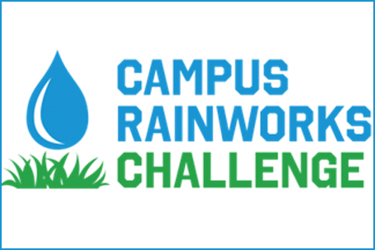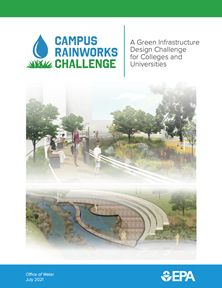Next-Generation Solutions To Stormwater And Personnel Challenges


In an industry beleaguered by workforce retirements, costly consent decrees, and climate-induced heavy rainfall events, fresh perspectives and ingenuity are high-profile needs. Fortunately, the U.S. EPA’s Campus RainWorks Challenge is designed to deliver exactly those benefits from the next generation of stormwater specialists. Here’s how current utilities, municipal planners, and consulting-engineer practices all stand to benefit.
What Is The Campus RainWorks Challenge?
The Campus RainWorks Challenge is a design competition intended to foster the interest and involvement of American college and university students in green infrastructure for stormwater management. It includes two categories — one for a demonstration project and one for a master plan of green infrastructure practices with beneficial effects for a broad cross section of each school’s campus. Eligibility extends to student teams from degree-granting public or private non-profit institutions of higher education (or community or technical colleges) located in the U.S., U.S territories, or U.S. possessions and to federally recognized Native American Tribal Governments, as described in the program’s competition brief (Figure 1). Minority academic institutions — including historically black colleges and universities, tribal colleges and universities, Hispanic-serving institutions, and Asian-American/Pacific Islander-serving institutions — are especially encouraged to participate. Teams consist of enrolled students and a sponsoring faculty advisor from any eligible institution of higher learning.

Source: U.S. EPA Website
Figure 1. The 17-page Campus RainWorks Challenge Competition Brief outlines program requirements that force participating student teams to take a professional approach to both the design and presentation aspects of the program. This prepares the individual participants for a wide range of tasks that they will face in their budding professional careers.
But the program also holds promise for water-sector utilities, their engineering counterparts, and municipal leaders who are responsible for improving stormwater control in their own communities. That includes anyone who is interested in green infrastructure as a means to protect source waters, minimize combined sewer overflows (CSOs), satisfy consent decrees, or otherwise reduce pressures on wastewater treatment plants (WWTPs) during heavy-rain events. Such professionals can consider the work of current and past participants in the competition to complement their recruitment and evaluation efforts and diversity goals for future interns and employees.
Far More Than Just An Extra-Credit Project
Because the EPA encourages contestants to consult with local green infrastructure professionals, students in the competition can be exposed to real-world pitfalls and experiences that can aid in their early professional development. For example, the 3-minute (maximum) ‘video pitch’ — a required part of the competition used to explain the project — gives students focused primarily on ecological or engineering coursework the opportunity to gain experience in presenting designs and business proposals that can prepare them for their professional careers. Also, working with their own campus facility professionals to research existing problems, costs, and objectives provides practical experience to prepare the competitors for their future professional challenges.
The videos from the 2020 RainWorks Challenge winners reflect an impressive cross section of work submitted by the participants. Here are just two of the many examples:
- The master-plan-category winning team from the University of Texas at Arlington combined technical, economic, and aesthetic concepts in a fast-paced video worthy of being delivered in any municipal presentation.
- This video from the University of Pennsylvania, the winner in the demonstration-project category, showed how rainwater collected from impervious areas of a schoolyard for use in an onsite food garden would reduce the school board’s stormwater fees by 80 percent in an area already plagued by CSOs.
An Industry-Focused Effort
The RainWorks Challenge is more than just an EPA publicity event or an academic exercise. It promotes real-work problem-solving experience among student participants across a wide range of disciplines — e.g., engineering, environmental, landscape architecture, etc. And it can result in practical benefits for their local schools and communities as well. In fact, over the previous nine years of the competition many project entries have come from schools located in stormwater-plagued communities already operating under consent decrees from the EPA.
To help close the gap between the academic and professional fields, the Campus RainWorks Challenge is actively supported by the Water Environment Federation (WEF), the American Society of Landscape Architects (ASLA), and the American Society of Civil Engineers (ASCE).
Registration for the 2021 competition runs from September 1 through October 1, 2021 and the deadline for final project submissions is December 10, 2021. Winners will be announced in the Spring of 2022. Interested parties should visit the EPA website to download the Campus RainWorks Challenge Competition Brief for complete program eligibility and entry details.
